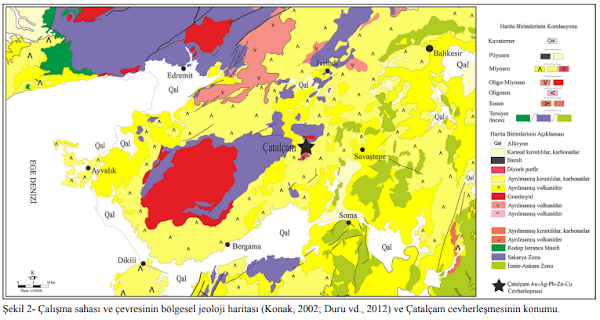Temiz Enerjiye Geçiş
Sürecinde Minerallerin Güvence Altına Alınmasında Yaşanan Zorluklar ve Fırsatlar
Xuan-Ce Wang
17 Ocak 2025
Temiz enerji teknolojilerine küresel geçiş, elektrikli
araçlar, güneş panelleri ve diğer karbonsuzlaştırma araçları için gerekli olan
kritik minerallere yönelik benzeri görülmemiş bir talebi teşvik ediyor. Bu
minerallerin arzını artırmada ilerleme kaydedilmiş olsa da, önemli boşluklar
kalmaya devam ediyor ve enerji geçişinde gecikmelere ve olumsuz çevresel,
ekonomik ve jeopolitik sonuçlara yol açma riski taşıyor. Bu yazıda, kritik
minerallerin sürdürülebilir bir arzını güvence altına almanın önündeki engeller
incelenmekte ve politika, yatırım ve inovasyon yoluyla uygulanabilir çözümler
araştırılmaktadır. Paydaşlar arasındaki iş birliğinin, adil ve verimli bir
geçiş için çok önemli olduğunun altı çizilmektedir.
KAYNAK
https://www.linkedin.com/pulse/securing-minerals-energy-transition-addressing-challenges-wang-k1tfc/
Securing Minerals for the Energy Transition: Addressing Challenges and Unlocking Opportunities
Executive Summary
The global shift to clean energy technologies is driving unprecedented demand for critical minerals essential for electric vehicles (EVs), solar panels, and other decarbonization tools. While progress has been made in increasing the supply of these minerals, significant gaps remain, risking delays in the energy transition and adverse environmental, economic, and geopolitical consequences. This report examines the barriers to securing a sustainable supply of critical minerals and explores actionable solutions through policy, investment, and innovation. Collaboration among stakeholders is emphasized as a linchpin for achieving an equitable and efficient transition.
1. Introduction
The energy transition’s success hinges on the availability of critical minerals, including lithium, cobalt, copper, and rare earth elements, which are indispensable for clean energy technologies. Projections indicate a 250% increase in demand for these minerals by 2030 under the International Energy Agency’s Net Zero Emissions by 2050 scenario. However, supply challenges, including long development timelines and geographic concentration, threaten to derail global decarbonization efforts.
Key Challenges
· Supply-demand imbalances that cause price volatility.
· Extended timelines from exploration to production.
· Environmental and community concerns regarding mining practices.
2. Barriers to Investment and Innovation
2.1 Financial Barriers
High Capital Expenditures: Developing new mining projects requires substantial upfront investment with long lead times before realizing returns.
Uncertain Business Cases: Scaling innovations, such as low-carbon mining techniques, often lacks a clear financial justification.
Financial Risks in Early-Stage Innovation: High failure rates in research and development (R&D) deter private sector investment.
2.2 Policy and Regulatory Challenges
Lengthy Permitting Processes: Permitting timelines average 16 years from discovery to production, slowing down resource mobilization.
Regulatory Complexity: Overlapping regulations create inefficiencies and discourage investment.
Community Resistance: Distrust arising from past environmental and social impacts can hinder project approval and execution.
2.3 Cross-Cutting Barriers
Lack of ESG Standardization: Varying environmental, social, and governance (ESG) standards create inconsistencies in mining practices.
Data Transparency: Limited availability of granular data on mineral flows impedes informed decision-making.
Skilled Labor Shortages: A declining number of mining graduates threatens to constrain the sector’s workforce.
3. Unlocking Solutions
3.1 Financial Incentives
Direct Support: Governments can provide tax credits, low-interest loans, and grants to de-risk investments in mining projects and innovations.
Private-Public Partnerships: Collaborative funding mechanisms can attract private investment and distribute risks.
Case Study: The US Department of Energy’s Loan Program Office has successfully supported mining and extraction projects through favorable financial instruments.
3.2 Policy Reforms
Streamlined Permitting: Simplifying regulatory processes can significantly reduce project timelines while maintaining ESG standards.
Harmonized Regulations: Aligning policies across jurisdictions minimizes compliance burdens and fosters international collaboration.
Demand Signals: Clear government targets, such as mandates for zero-emission vehicles, can enhance investor confidence.
3.3 Technological Innovation
Exploration Technologies: Advanced geospatial mapping and AI-driven analytics can accelerate mineral discovery.
Sustainable Mining Practices: Innovations like low-carbon processing and closed-loop water systems reduce environmental impacts.
Recycling and Circular Economy: Enhancing secondary supply chains through efficient recycling technologies can alleviate primary resource pressures.
4. Stakeholder Collaboration
4.1 Multilateral Cooperation
Organizations like the World Economic Forum’s Securing Minerals for the Energy Transition (SMET) initiative play a critical role in convening stakeholders to share knowledge and align strategies.
4.2 Industry Partnerships
Strategic Alliances: Partnerships between upstream miners and downstream manufacturers can secure supply chains and boost ESG compliance.
Innovation Consortia: Collaborative R&D efforts among companies, academia, and governments accelerate technology deployment.
4.3 Community Engagement
Social License to Operate: Companies must prioritize community involvement, ensuring equitable benefits and addressing environmental concerns.
Case Study: The Democratic Republic of Congo’s collaboration with China to develop mining infrastructure has provided local employment and improved public services.
5. Strategic Actions and Next Steps
For Governments
· Develop integrated national strategies to streamline permitting and incentivize sustainable mining.
· Establish international trade agreements to ensure supply chain resilience.
For Industry Players
· Invest in low-carbon technologies and establish transparent ESG metrics.
· Formulate long-term offtake agreements to stabilize demand and encourage innovation.
For Financial Actors
- Create financial instruments to mitigate investment risks in critical minerals.
- Collaborate with early-stage innovators to bridge funding gaps.
6. Conclusion
Securing a stable and sustainable supply of critical minerals is imperative for the global energy transition. Addressing financial, regulatory, and technical barriers requires coordinated efforts across governments, industries, and communities. By fostering innovation, aligning policies, and engaging stakeholders, the path to a decarbonized future becomes achievable and equitable. Stakeholders must act swiftly to overcome challenges and unlock the opportunities presented by this pivotal moment in the energy transition.
References: Cited publications and reports, including contributions from the World Economic Forum, McKinsey & Company, and the International Energy Agency.
Acknowledgments
This report acknowledges the contributions of the Securing Minerals for the Energy Transition initiative, led by the World Economic Forum in collaboration with McKinsey & Company. Insights from industry leaders, academics, and policymakers have informed its development.






Yorumlar
Yorum Gönder